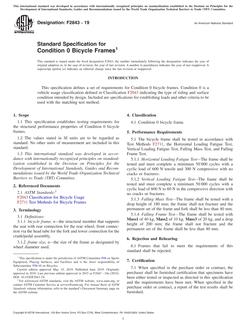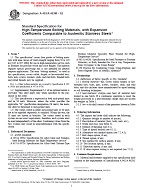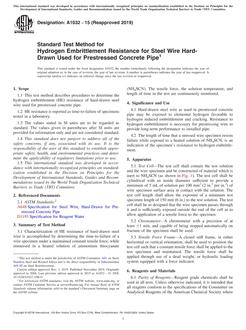1.1 This test method covers the non-adiabatic determination of the spontaneous heating values (SHV) of liquids and solids. It is applicable to substances that are not completely volatile at the test temperature. Spontaneous heating values obtained by this test method are qualitative indications of the degree of self-heating that may be expected to occur upon exposure of the sample to air at the test temperature.
1.2 Values obtained by this method are applicable to liquids and solids supported on cellulosic surfaces. They are not applicable to liquids on metal surfaces, on contaminated surfaces, or at pressures above atmospheric.
1.3 Spontaneous heating values determined by the present test method are regarded only as qualitative measurements of self-heating which occurs under the conditions of the test. The test method does not purport to produce a quantitative measure of the enthalpy of reaction of the sample with air at a given test temperature. Such data can be obtained by the use of an adiabatic calorimeter. The existence, under the test conditions, of a positive temperature difference between the sample and the reference is evidence of a thermochemical reaction in the sample.
1.4 The magnitude of the measured temperature difference is a semiquantitative indication of the enthalpy and rate of that reaction. Since factors such as heat loss from the sample to the bath and quenching of the reaction due to too rapid consumption of oxygen affect the amount and duration of the measured heat effect, care must be taken not to attribute too much quantitative significance to the test results. It is sufficient, for the purpose of this test, to determine whether or not the sample is capable of undergoing a self-heating reaction of sufficient magnitude and rapidity to produce a detectable thermal effect. The spontaneous heating value (SHV) can be lower than the test temperature. A negative result does not preclude spontaneous heating initiating at a temperature higher than the test temperature.
1.5 This standard should be used to measure and describe the response of materials, products, or assemblies to heat and flame under controlled conditions and should not be used to describe or appraise the fire-hazard or fire-risk of materials, products, or assemblies under actual fire conditions. However, results of this test may be used as elements of a fire-hazard assessment or a fire-risk assessment which takes into account all of the factors which are pertinent to an assessment of the fire hazard or fire risk of a particular end use.
1.6 The values stated in SI units are to be regarded as the standard. In cases where materials, products or equipment are available in inch-pound units only, SI units are omitted.
This standard does not purport to address all of the safety concerns, if any, associated with its use. It is the responsibility of the user of this standard to establish appropriate safety and health practices and determine the applicability of regulatory limitations prior to use.
Product Details
- Published:
- 05/01/2007
- Number of Pages:
- 4
- File Size:
- 1 file , 79 KB


